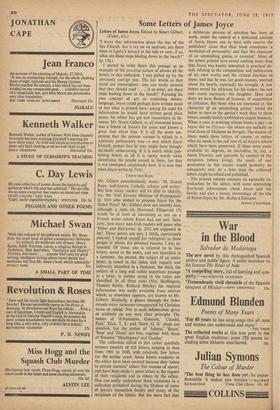Some Letters of James Joyce
Letters of James Joyce. Edited by Stuart Gilbert. (Faber, 42s.)
'I WANT that information about the star of the Sea Church, has it ivy on its seafront, are there trees in Leahy's terrace at the side or near, if so, what are these steps leading down to the beach?' (p. 136.) I started to write down this passage as an example of the practical nature of almost all the letters in this collection. I was pulled up by the obviously corrupt text. The last words as they stand are meaningless : one can easily surmise that they should read 4. . . if so what, are there steps leading down to the beach?' Pursuing his own concept of art, or exploiting dream- language, Joyce could perhaps have written more or less what is printed here; asking his aunt for information he would have written good plain prose; his editor has got lost somewhere in be- tween. Mr. Stuart Gilbert, as all interested know, was a friend of Joyce's for years and knows a great deal about him. It is all the more sur- prising that the present volume is edited in a relatively perfunctory way—a way which Joyce himself, pedant that he was, might have thought decidedly unbecoming. If it is worth while pub- lishing letters at all it is surely worth while identifying the people named in them, but that is not attempted consistently here. It is true that when Joyce writes (p. 314):
I never met Rops.
Mr. Gilbert conscientiously notes : 'M. Daniel Rops, well-known Catholic scholar and writer.' But how many readers will be able to identify, say, the 'Dail Eireann Minister of Propaganda' (p. 181) who wished to propose Joyce for the Nobel Prize? Mr. Gilbert does not identify him, although a note on Desmond Fitzgerald (?) would be at least as interesting as one on a French writer whom Joyce had not met. Simi- larly, how many non-Irish readers will guess who 'Hiber and Hairyman' (p. 295) are supposed to be? These points are not, I think, capriciously selected. I looked myself for references to three people in whom, for personal reasons, I was in- terested. Of these, one is referred to in two letters, noted in the index, and not identified in a footnote; the second, the subject of an entire letter, is noted in the index and vaguely and indirectly identified in a footnote; the third, the subject of a long and rather important passage in a letter, is neither noted in the index nor identified. In all three cases (Mrs. Skeffington, Thomas Kettle, Richard Sheehy) the required information was easily available from sources which, as elsewhere appears, are known to Mr. Gilbert. Similarly, a glance through the index reveals many surnames unsupported by Christian name or initial. Nor is such information given or withheld on any very clear principle. The names of 4d'Annunzio, Gabriele,"Claudel, Paul,' `Eliot, T. S.' and 'Shaw, G. B.' abide our question, but the names of 'Adams,' Bence,' 'Buss' and 'Dunn' are free, together with those of 'Einstein,' Hemingway' and 'Goethe.'
The collection edited in this rather quietistic manner consists of 426 letters, ranging in time from 1901 to 1940, with relatively few letters for the earlier years. Some letters available to the editor have been omitted because they 'relate to private matters,' others 'for reasons of space'; cuts have been made in some letters at the request of their recipients and in others by the editor. One can easily understand these omissions in a collection published during the lifetime of some of Joyce's immediate family and many of the recipients of the letters. But the mere fact that a deliberate process of selection has been at work, under the control of a dedicated admirer of Joyce, forces one to treat with reserve the publishers' claim that their book constitutes 'a revelation of personality' and that 'the character of an astonishing genius is revealed.' Most of the letters printed here reveal nothing more than that Joyce was keenly interested in practical de- tails relating to the composition and publication of his own works and the critical' reaction to them; and that he was, for good reasons, worried about his health, especially his eyesight. A few letters reveal his affection for his father, his son and—more anxiously—his daughter. Here and there we have flashes of humour, of superstition or irritation. But those who are interested in 'the character of an astonishing genius' would do better to turn to the genius's work than to these letters, usually hastily scribbled on urgent business. When a man is working sixteen hours a day—as Joyce did on Ulysses—his letters are unlikely to rival those of Madame de Sevigne. The student of Joyce needs these letters, of course; or rather what he needs is the full text of all Joyce's letters which have been preserved. If these were made available by degrees, on microfilm, in, say, a dozen libraries, and quotable by consent of the recipients (where living), the needs of our generation in this matter would probably be adequately met. At a later time the collected letters might be edited and published.
The present volume contains an agreeable in- troduction by the editor, with some interesting first-hand information about Joyce and his family and also a handy chronology of the life of James Joyce by Mr. Richard Ellmann.
DONAT O'DONNELL


































 Previous page
Previous page